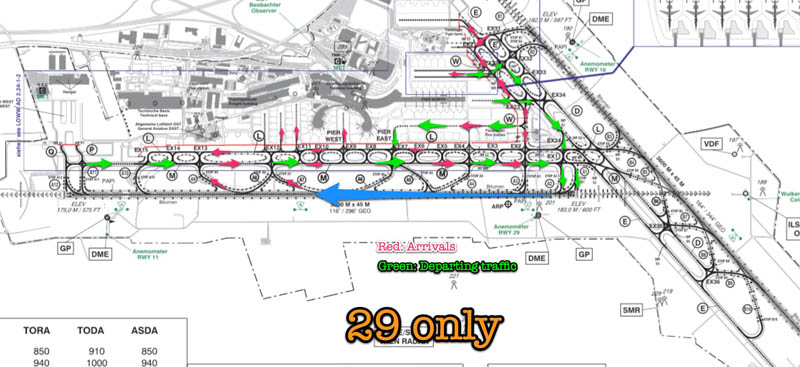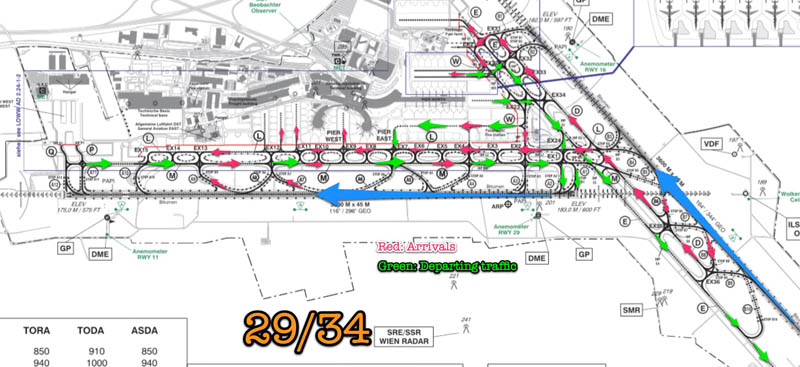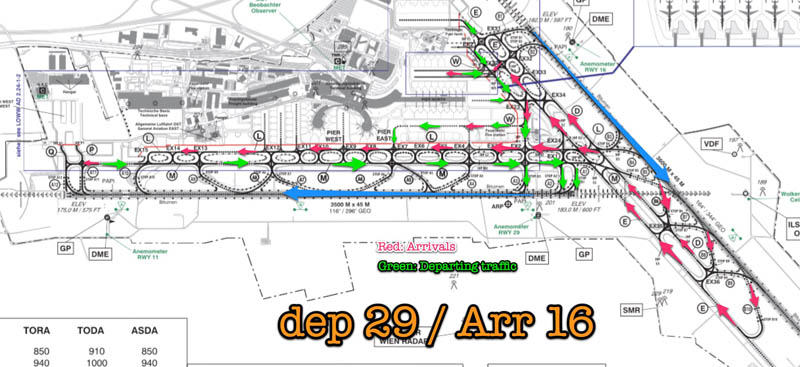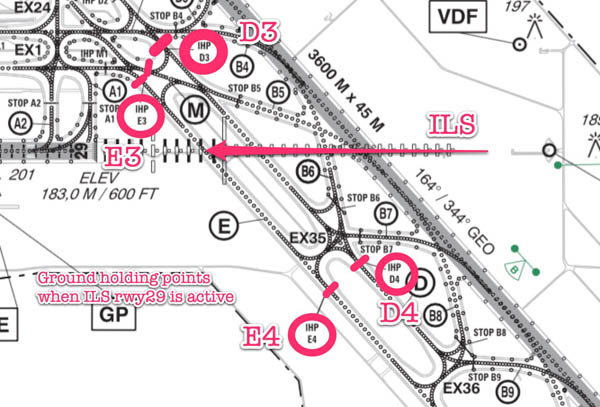Difference between revisions of "LOWW Primer"
Claus Faber (talk | contribs) |
Claus Faber (talk | contribs) |
||
| Line 74: | Line 74: | ||
Runway 16/34 crosses the final approach for runway 29. The ILS beacon for runway 29 runs right across taxiway E, D and the runway. | Runway 16/34 crosses the final approach for runway 29. The ILS beacon for runway 29 runs right across taxiway E, D and the runway. | ||
| − | This means, that there is no traffic allowed on the relevant sections of D and E, if there is any aircraft in approach for runway 29. There are intermediate | + | This means, that there is no traffic allowed on the relevant sections of D and E, if there is any aircraft in approach for runway 29. There are intermediate holding points (in the chart: "IHP"), conditional clearances must be issued: |
GND: Austrian 123, taxi to stand C31 via E and M, hold short at E4 until the approaching 737 on final runway 29 has landed. | GND: Austrian 123, taxi to stand C31 via E and M, hold short at E4 until the approaching 737 on final runway 29 has landed. | ||
Revision as of 07:37, 11 June 2017
About this Document
This document is intended as training and reference material for controlling Vienna Airport (LOWW). This page is work in progress. If you are controller: Feel free to discuss and edit.
If you are a Pilot: The page Vienna is a better source for you, with more info on flying airplanes and less on controlling.
AIRAC status is 1704 (May 2017).
The structure of this document follows the stations to be manned: DEL, GND, TWR, APP.
Overview
Vienna has two runways, which flight paths cross. Still, the airport has frequencies which make parallel operations necessary - therefore, Vienna has developed a set of special rules and practices on how to use them.
Ground
(see the ground chart [which you find here]).
Vienna has three piers with gates and some stands around. From West to East, there are:
- General Aviation West is all the way to the West at Taxiways Q and P.
- Some stands at the maintainance area (A91 to A99)
- General Aviation East is near EX13.
- Two rarely used stands (B52 and B62) are next
- Near EX12, there are three rows for small commercial airliners B71 to B92).
- Pier West (gates C31 to C42) and Pier East (D21 to D29) are next. They all match M aircraft, with the corner stands C36, C39, D23, D26 and D28) for H aircraft too.
- Pier North or "Skylink" is relatively new (and most likely the most expensive pier after BER airport *irony*), providing gates to the South (F01-F37, odd numbers) and the North F04-F36, even numbers).
Besides to the East, there are stands for large aircraft - currently the only places for the A380.
- South of Pier North are stands for smaller and budget airliners (the E stands).
- North of Pier North is another row for the same (the H stands).
Taxiways
- Two parallel taxiways (L and M) run along runway 11/29. Caution: Taxiway L after EX12 is narrower and cannot be used for M and H aircraft.
- Runway 16/34 have another two taxiways: D and E. D is somehow shorter, E goes through all the way.
- An extra taxiway (W) leads from EX2 to EX21.
- Then there are some taxilanes to access Pier North (TL35, 36 and 37 to the South of the pier, TL40 to the North). TL40 has a blue (south) and an orange (north) variant, which not all sceneries have, so be aware if pilots can see it.
DEL - Delivery position
Delivery in Wien is straightforward as described in the Study_Guide:Delivery. Bear in mind the following factors:
- There is a Noise Abatement procedure after 21:00 local time, which changes runways to 29-only, if wind permits. Cleared SIDs after 21:00 change.
- VFR traffic does not necessary depart or land from the runway in use - coordinate with TWR, what to clear, and if TWR or DEL clears).
GND - Ground Position
Ground position in Vienna is somehow complicated. Why? Because traffic flow changes with runway configuration, and sometimes traffic flows left-around.
Taxiing with 29-only
With strong westerly wind and after 21:00 local, 29-only is the option. This the option for minimizing conflicts:
Taxiing with 29-34
When wind is Northwesterly, then departing 29 and arriving 34 is an option.
Traffic flow could be as follows:
Taxiing with 11-16
Vienna has a local procedure to have quasi-parallel operation of runway 11 and 16. In this configuration, aircraft depart from 16. Arrivals are 11 and 16 depending on traffic and aircraft class (Heavies cannot approach 11 if 16 is open, as go-around paths would cross). Taxiing is somehow complex in this situation:
You could handle the flow like this, which will turn L and M to left-around to minimise conflicts. There is a hot spot at EX23, where outbound and inbound traffic cross. However, departing traffic will be able to see departing on their right hand side, so you can work with conditional clearances ("give way to crossing traffic from D at Exit 23").
Taxiing with 29-16
When the wind is low, but southerly, then 29-16 is a good option. This is how you can handle it:
Restrictions to Ground Movement
Runway 16/34 crosses the final approach for runway 29. The ILS beacon for runway 29 runs right across taxiway E, D and the runway.
This means, that there is no traffic allowed on the relevant sections of D and E, if there is any aircraft in approach for runway 29. There are intermediate holding points (in the chart: "IHP"), conditional clearances must be issued:
GND: Austrian 123, taxi to stand C31 via E and M, hold short at E4 until the approaching 737 on final runway 29 has landed. AUA123: taxiing C31 via E and M, holding short at E4, aircraft in sight.




